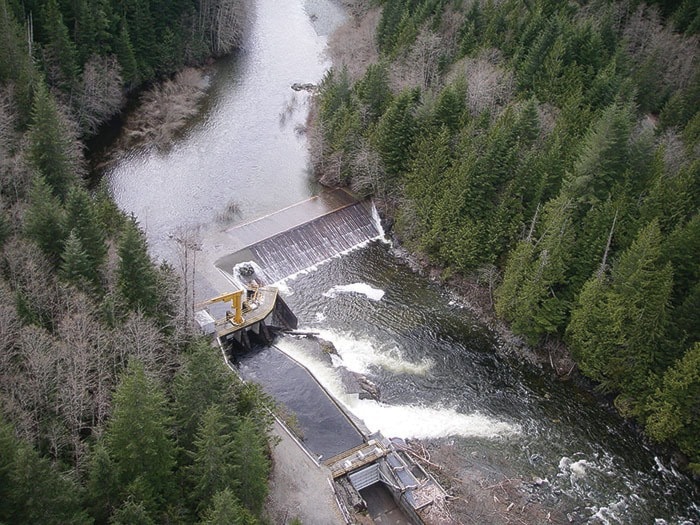BC Hydro’s fish passage and dam safety improvements slated for their Salmon River water diversion facility north of Campbell River are moving along with work planned for 2016.
“The focus of the project is to firstly improve adult fish passage past the dam so coho and steelhead, and recently chinook, can access upstream fish habitat and increase productivity,” says BC Hydro’s Stephen Watson. “The fish ladder design has progressed nicely and we’re looking forward to work beginning in spring 2016 and having it complete by that November.”
Since the 1990s when the first fish ladder was installed, minimum downstream river flows passed through the hydroelectric facility by going under a sluice gate. As flows increased, water would then flow through the fish ladder and eventually spill over the dam and over a canal wall, where the flow velocities would be too much for fish to move through.
“The significant new change is that the sluice gate will be closed and therefore most of the water flows, certainly in the lower flow ranges, will go through the fish ladder,” says Watson. “The fish ladder will be significantly larger than the existing one and be operable to a much broader range of flows for the benefit of fish passage.”
There will be improvements to the upstream side of the facility that includes a debris guard to deflect woody debris away from the fish ladder and sluice gate areas and over the dam. The water level just upstream of the dam will be held at a slightly higher level to provide this debris management and to improve flow control through the fish ladder.
BC Hydro is co-managing the upstream fish passage works with two First Nations.
“Through a technical committee, that includes provincial and federal fish agencies, we have been working together to develop a good solution, where even at higher river flow rates fish should be able to move upstream,” says Brian Assu of the We Wai Kai Nation. “With the existing facility, medium river flow rates can be a barrier to fish passage.”
“When fish arrived at the diversion dam they saw water coming at them from all sorts of directions and no doubt it was confusing to them – where do they go?” says Dean Drake of the Campbell River Indian Band. “Now, with this design, there will essentially be one attraction flow they will move towards and that’s the entrance to the fish ladder. When flows are going over the dam, that ladder entrance will still be a significant attraction to them.”
The K’omoks First Nation is on the technical committee.
Watson said the refinements of the facility design and procurement process are being finalised.
BC Hydro has also made a decision on the fish screen flow thresholds within the canal when water is being diverted into the Campbell River system for power generation and other water use interests. The fish screen diverts fish that inadvertently enter the canal back into the Salmon River. The new screen and other dam safety improvements are planned for 2017 and 2018.
“We can divert up to 42 m3/s in the canal but there are certain times of the year when fish are moving through the system and the fish screen must be in place,” says Watson. “For quite some time now we have been diverting up to 15 m3/s during those key periods, because at flows above that level, the existing screen can be pushed out of position. Given the cost, complexities and the amount of water potentially diverted, given the hydrological history, we decided it prudent to design a better fish screen for the same 15 m3/s diversion flow rate.”
The existing fish screen, built in the 1980s, is positioned horizontal and angled downward, which is not ideal, and push fish down and to the side where they enter a pipe that takes them back to the Salmon River. With the new design that is in the planning stages, the screen will be vertical and angled downstream to slowly push fish off to the side of the canal and into the pipe, no matter where they are in the water column.
On Oct. 21, BC Hydro provided an update on the Salmon River Diversion Canal Refurbishment & Fish Passage Improvement Project to their community liaison committee. The committee, consisting of about two-dozen stakeholders, meets three times a year.
